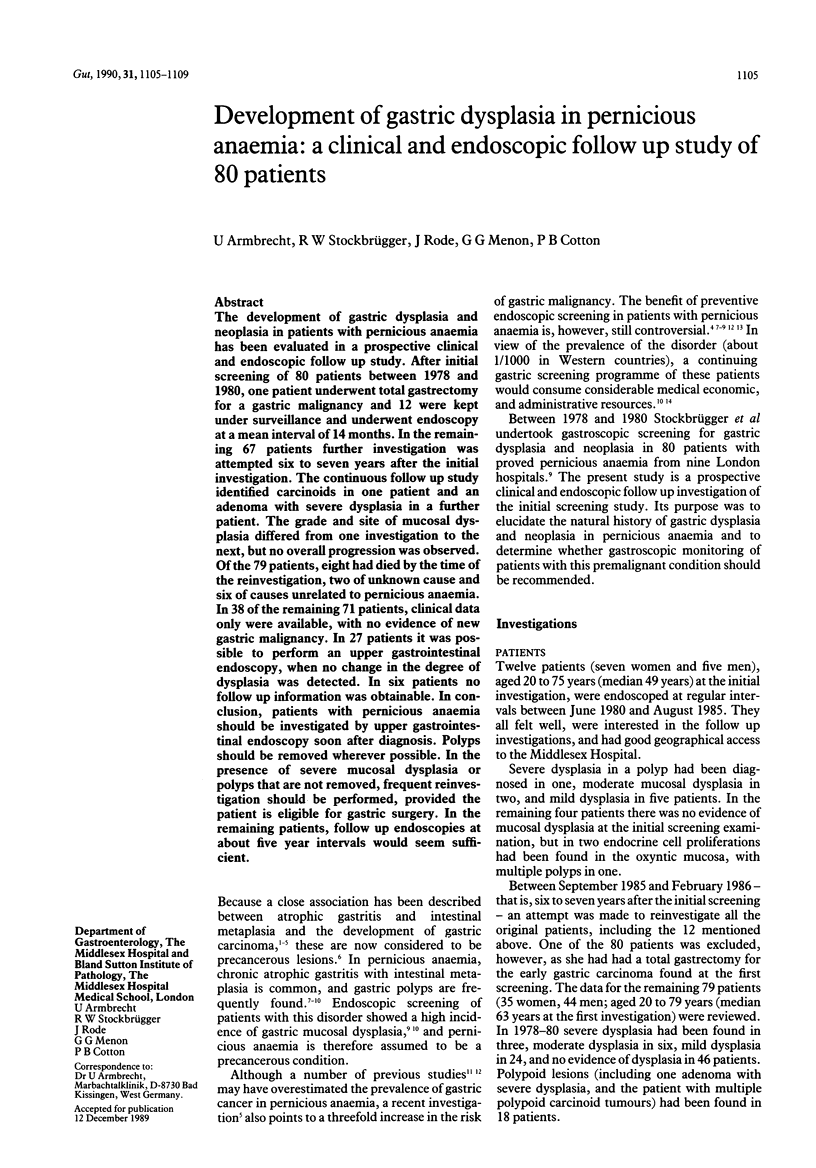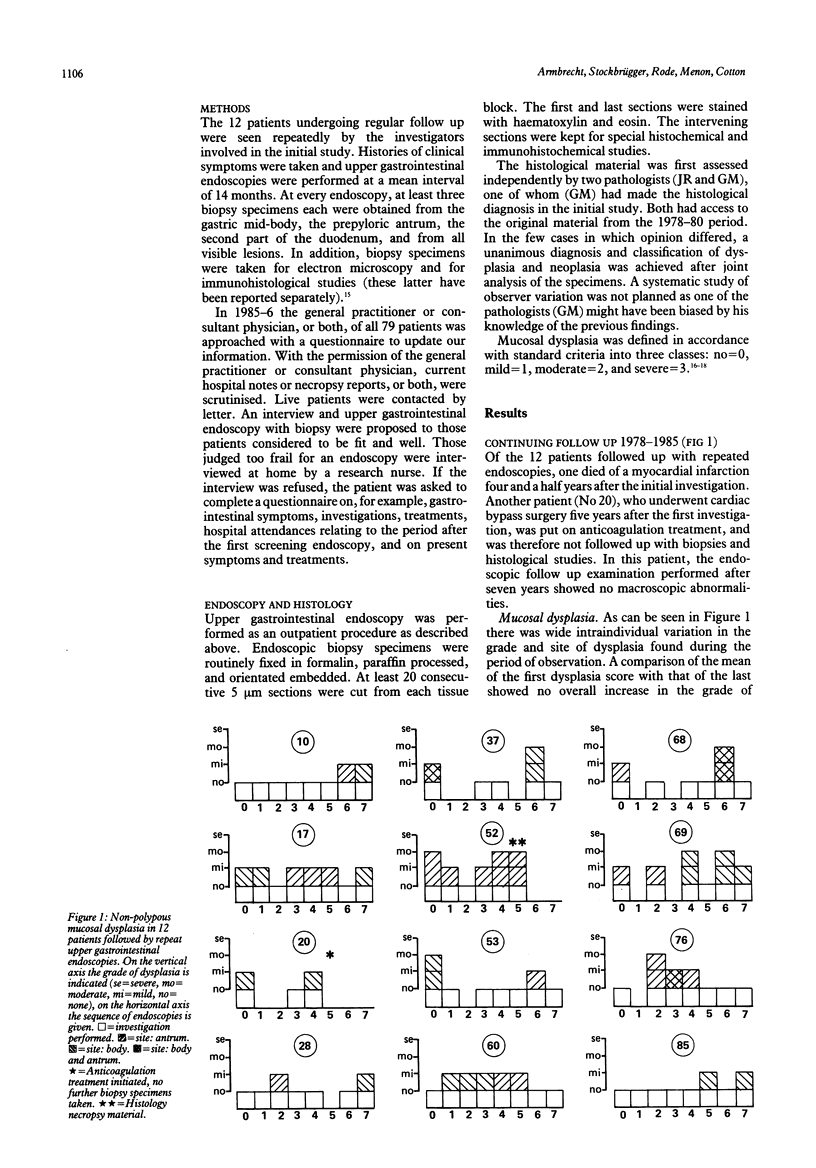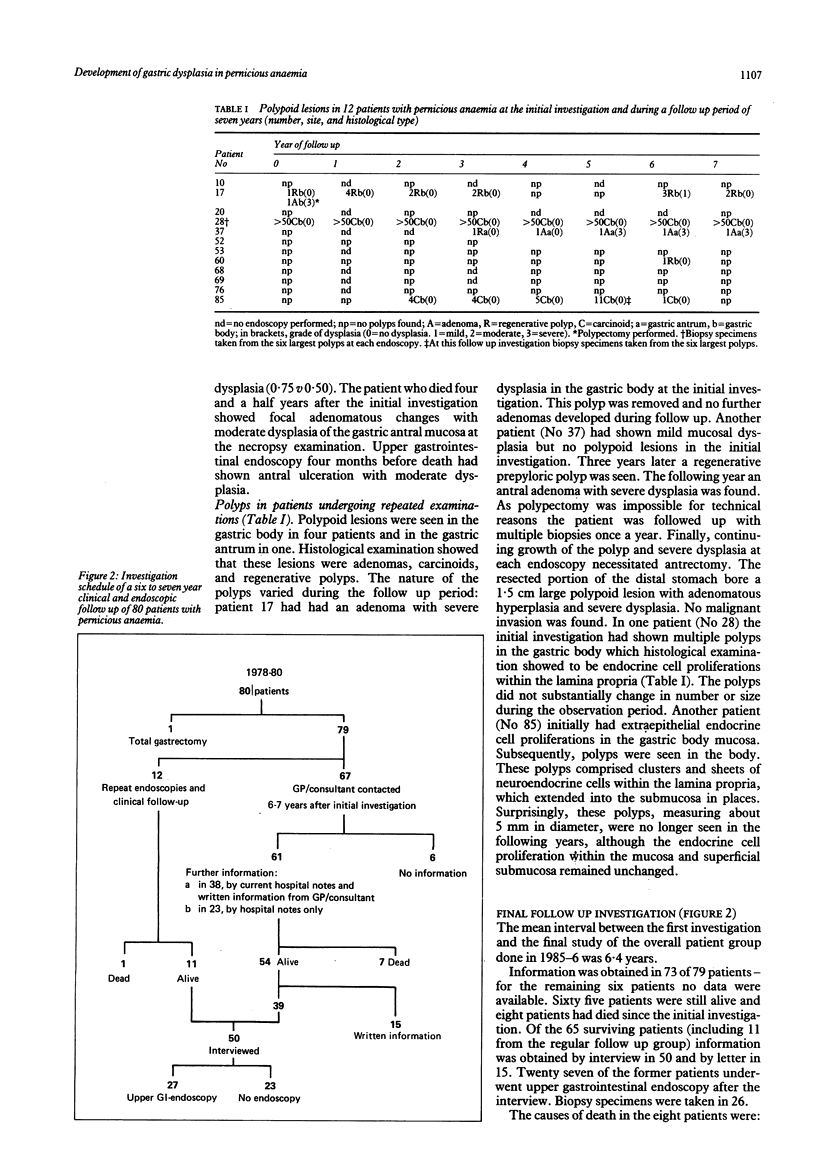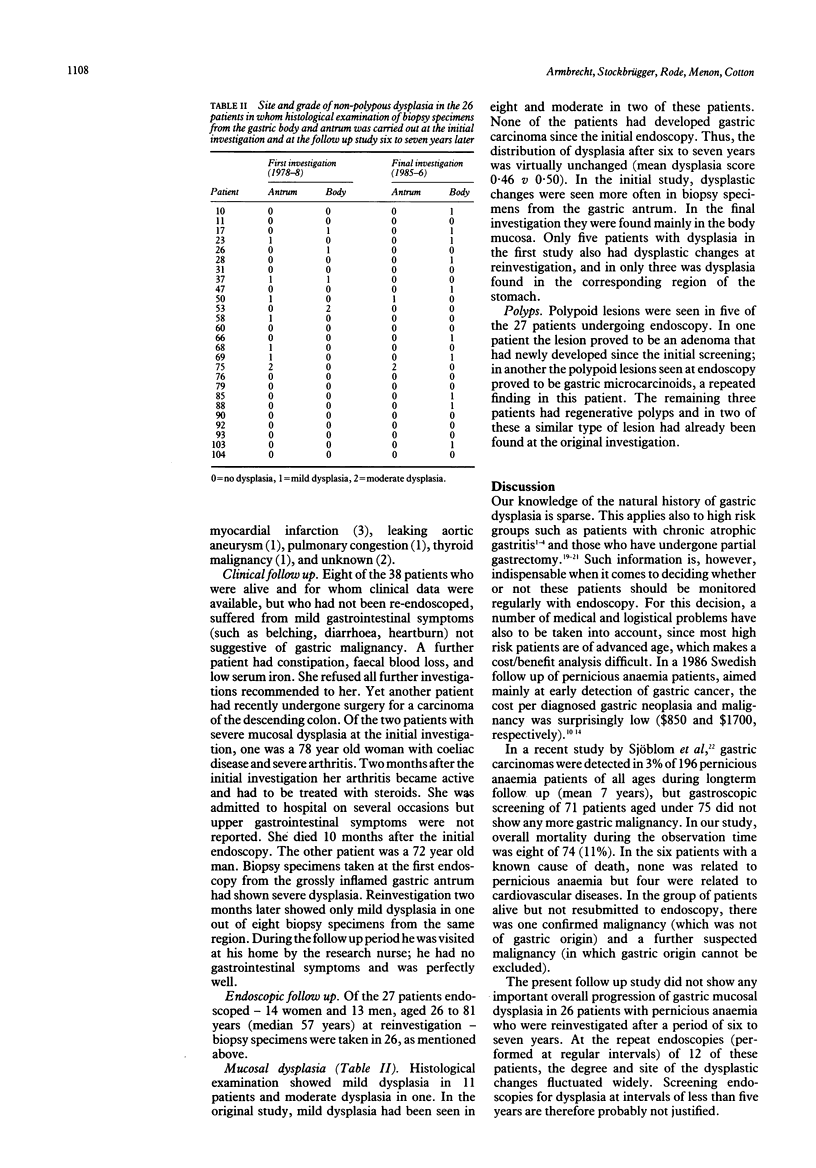Abstract
The development of gastric dysplasia and neoplasia in patients with pernicious anaemia has been evaluated in a prospective clinical and endoscopic follow up study. After initial screening of 80 patients between 1978 and 1980, one patient underwent total gastrectomy for a gastric malignancy and 12 were kept under surveillance and underwent endoscopy at a mean interval of 14 months. In the remaining 67 patients further investigation was attempted six to seven years after the initial investigation. The continuous follow up study identified carcinoids in one patient and an adenoma with severe dysplasia in a further patient. The grade and site of mucosal dysplasia differed from one investigation to the next, but no overall progression was observed. Of the 79 patients, eight had died by the time of the reinvestigation, two of unknown cause and six of causes unrelated to pernicious anaemia. In 38 of the remaining 71 patients, clinical data only were available, with no evidence of new gastric malignancy. In 27 patients it was possible to perform an upper gastrointestinal endoscopy, when no change in the degree of dysplasia was detected. In six patients no follow up information was obtainable. In conclusion, patients with pernicious anaemia should be investigated by upper gastrointestinal endoscopy soon after diagnosis. Polyps should be removed wherever possible. In the presence of severe mucosal dysplasia or polyps that are not removed, frequent reinvestigation should be performed, provided the patient is eligible for gastric surgery. In the remaining patients, follow up endoscopies at about five year intervals would seem sufficient.
Full text
PDF




Selected References
These references are in PubMed. This may not be the complete list of references from this article.
- Borch K. Epidemiologic, clinicopathologic, and economic aspects of gastroscopic screening of patients with pernicious anemia. Scand J Gastroenterol. 1986 Jan;21(1):21–30. doi: 10.3109/00365528609034616. [DOI] [PubMed] [Google Scholar]
- Borch K., Liedberg G. Prevalence and incidence of pernicious anemia. An evaluation for gastric screening. Scand J Gastroenterol. 1984 Mar;19(2):154–160. [PubMed] [Google Scholar]
- Borch K., Renvall H., Liedberg G. Gastric endocrine cell hyperplasia and carcinoid tumors in pernicious anemia. Gastroenterology. 1985 Mar;88(3):638–648. doi: 10.1016/0016-5085(85)90131-3. [DOI] [PubMed] [Google Scholar]
- Elsborg L., Andersen D., Myhere-Jensen O., Bastrup-Madsen P. Gastric mucosal polyps in pernicious anaemia. Scand J Gastroenterol. 1977;12(1):49–52. [PubMed] [Google Scholar]
- Elsborg L., Mosbech J. Pernicious anaemia as a risk factor in gastric cancer. Acta Med Scand. 1979;206(4):315–318. doi: 10.1111/j.0954-6820.1979.tb13517.x. [DOI] [PubMed] [Google Scholar]
- Eriksson S., Clase L., Moquist-Olsson I. Pernicious anemia as a risk factor in gastric cancer. The extent of the problem. Acta Med Scand. 1981;210(6):481–484. doi: 10.1111/j.0954-6820.1981.tb09854.x. [DOI] [PubMed] [Google Scholar]
- Harvey R. F. Spontaneous resolution of multifocal gastric enterochromaffin-like cell carcinoid tumours. Lancet. 1988 Apr 9;1(8589):821–821. doi: 10.1016/s0140-6736(88)91677-7. [DOI] [PubMed] [Google Scholar]
- Hermanek P. Dysplasia in the gastrointestinal tract: definition and clinical significance. Surg Endosc. 1987;1(1):5–10. doi: 10.1007/BF00703080. [DOI] [PubMed] [Google Scholar]
- Laxén F. Gastric carcinoma and pernicious anaemia in long-term endoscopic follow-up of subjects with gastric polyps. Scand J Gastroenterol. 1984 Jun;19(4):535–540. [PubMed] [Google Scholar]
- Morson B. C., Sobin L. H., Grundmann E., Johansen A., Nagayo T., Serck-Hanssen A. Precancerous conditions and epithelial dysplasia in the stomach. J Clin Pathol. 1980 Aug;33(8):711–721. doi: 10.1136/jcp.33.8.711. [DOI] [PMC free article] [PubMed] [Google Scholar]
- NORCROSS J. W., MONROE S. E., GRIFFIN B. G. The development of gastric carcinoma in pernicious anemia. Ann Intern Med. 1952 Aug;37(2):338–343. doi: 10.7326/0003-4819-37-2-338. [DOI] [PubMed] [Google Scholar]
- Offerhaus G. J., Stadt J., Huibregtse K., Tytgat G. Endoscopic screening for malignancy in the gastric remnant: the clinical significance of dysplasia in gastric mucosa. J Clin Pathol. 1984 Jul;37(7):748–754. doi: 10.1136/jcp.37.7.748. [DOI] [PMC free article] [PubMed] [Google Scholar]
- Rode J., Dhillon A. P., Papadaki L., Stockbrügger R., Thompson R. J., Moss E., Cotton P. B. Pernicious anaemia and mucosal endocrine cell proliferation of the non-antral stomach. Gut. 1986 Jul;27(7):789–798. doi: 10.1136/gut.27.7.789. [DOI] [PMC free article] [PubMed] [Google Scholar]
- SIURALA M., SEPPALA K. Atrophic gastritis as a possible precursor of gastric carcinoma and pernicious anemia. Results of follow-up examinations. Acta Med Scand. 1960 May 5;166:455–474. doi: 10.1111/j.0954-6820.1960.tb17401.x. [DOI] [PubMed] [Google Scholar]
- Schrumpf E., Serck-Hanssen A., Stadaas J., Aune S., Myren J., Osnes M. Mucosal changes in the gastric stump 20-25 years after partial gastrectomy. Lancet. 1977 Sep 3;2(8036):467–469. doi: 10.1016/s0140-6736(77)91599-9. [DOI] [PubMed] [Google Scholar]
- Siurala M., Lehtola J., Ihamäki T. Atrophic gastritis and its sequelae. Results of 19-23 years' follow-up examinations. Scand J Gastroenterol. 1974;9(5):441–446. [PubMed] [Google Scholar]
- Siurala M., Varis K., Wiljasalo M. Studies of patients with atrophic gastritis: a 10-15-year follow-up. Scand J Gastroenterol. 1966;1(1):40–48. doi: 10.1080/00365521.1966.11800612. [DOI] [PubMed] [Google Scholar]
- Stockbrügger R. W., Menon G. G., Beilby J. O., Mason R. R., Cotton P. B. Gastroscopic screening in 80 patients with pernicious anaemia. Gut. 1983 Dec;24(12):1141–1147. doi: 10.1136/gut.24.12.1141. [DOI] [PMC free article] [PubMed] [Google Scholar]
- Svendsen J. H., Dahl C., Svendsen L. B., Christiansen P. M. Gastric cancer risk in achlorhydric patients. A long-term follow-up study. Scand J Gastroenterol. 1986 Jan;21(1):16–20. doi: 10.3109/00365528609034615. [DOI] [PubMed] [Google Scholar]
- Viste A., Bjørnestad E., Opheim P., Skarstein A., Thunold J., Hartveit F., Eide G. E., Eide T. J., Søreide O. Risk of carcinoma following gastric operations for benign disease. A historical cohort study of 3470 patients. Lancet. 1986 Aug 30;2(8505):502–505. doi: 10.1016/s0140-6736(86)90368-5. [DOI] [PubMed] [Google Scholar]
- ZAMCHECK N., GRABLE E., LEY A., NORMAN L. Occurrence of gastric cancer among patients with pernicious anemia at the Boston City Hospital. N Engl J Med. 1955 Jun 30;252(26):1103–1110. doi: 10.1056/NEJM195506302522601. [DOI] [PubMed] [Google Scholar]


